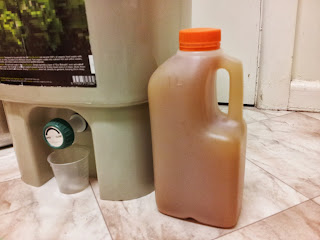 |
| Eco Bokashi, 20L Eco Bokashi Bucket, cup and mashing utensil |
 |
| Spread a layer of Eco Bokashi (about 1/3 cup) over the food waste |
 |
| compress the food waste with mashing utensil |
 |
| Drain the bokashi juice once or twice a week |
Bokashi Juice can be diluted with water and with many usage
This is how I use the ECO BUCKET
1. Place Eco Bucket somewhere close to food/kitchen waste
2. Place the drain plate supplied into the base of ECO BUCKET
3. Add Food/kitchen wastes into the ECO BUCKET
4. At the end of the day, spread a layer (1/3 cup) of ECO BOKASHI over the food waste and compress the food waste in the bucket with mashing utensil
5. Reseal the airtight ECO BUCKET lid
6. Once or twice a week, drain the liquid `Bokashi Juice' from the bucket
7. Once the ECO BUCKET is full, empty the content into small hole or trench approximate 20cm deep and cover with soil. The waste material need to go into soil to physically break down
What can I put into the ECO BUCKET:-
1. vegetable and fruit scraps
2. tea leaves
3. tea bags
4. small amount of paper
5. coffee ground
6. onions, citrus and garlic
7. meat scraps
8. seafood/fish
9. cooked food waste
How often should I drain the bokashi Juice and the usage
Drain Bokashi Juice twice every week or as required
Bokashi Juice is full of friendly microbs and nutrients for plants and stop the drain smelling
It contains nutrients from the food waste and is alive with friendly micro-organisms and is natural nutrient and fertiliser for the plant!
It also stop the drain and toilet smelling.
Bokashi juice must be diluted prior to use in your plants or garden
For Garden use:-
1. Dilute 1:1000 with water for foliar spray
2. Dilute 1:100 with water for lawns and garden beds
For toilet and septic tank and drain
1. Undiluted add directly into toilet or septic tank
2. Undiluted for
Advantages of Eco Bucket
1. Air tight so there will be no insect problems
2. Fermentation process prevent foul odour
The treated food waste in the ECO BUCKET will actively FERMENT, not decompose, while in the bucket
Imagine a pickled onion or garlic...it looks like an onion or garlic but because it's pickled it will have changed its internal structure
Fermented contents of the bucket can be transferred directly into the soil of your garden where it will breakdown rapidly.
In 2-3 weeks the buried waste will be mostly broken down into soil, providing a usable nutrient rich end-product and improving the soils levels of nutrients, microbes and enzymes
Fermentation is an alternative sustainable method of recycling food waste versus traditional dumping food waste into landfill.
You can halve your Rubbish to Landfill by composting or fermenting
Fermentation directly reduces greenhouse gas emissions (specifically Methane which is cause by rotting organic matter).
Each kg of food waste dumped into landfill produces 900 gm of Methane (primary greenhouse gas or Carbon Dioxide equivalent CO2e )
So over the period of a year you are reducing many kg of CO2e being placed in the atmosphere
You can get BOKASHI BUCKET from some nurseries, environmental shops and online.. It is best to have 2 buckets, so when one fills up you can leave it to ferment for a while and start using the other. But if you only have one, you don't have to leave it to ferment.
HAPPY TRYING!!!! Please help to save our mother earth!!





